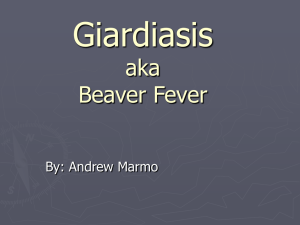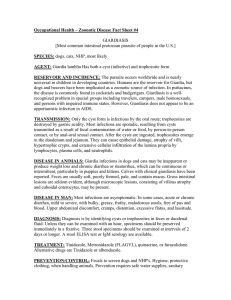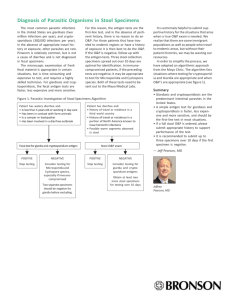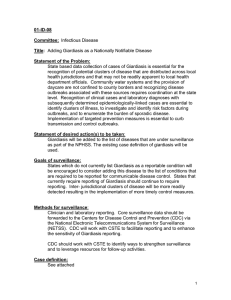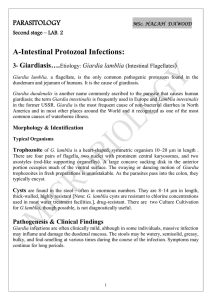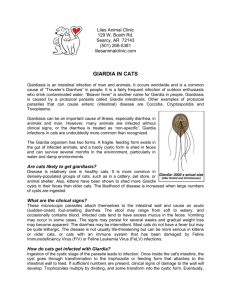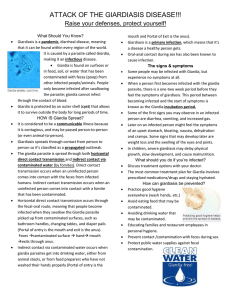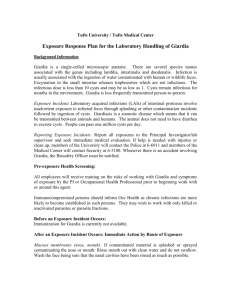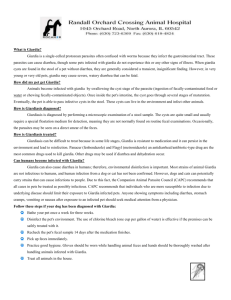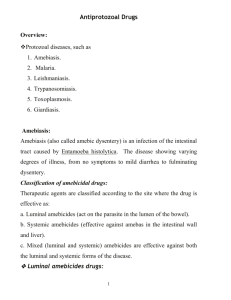Disease The case definition of giardiasis, a disease under public health... a revision.
advertisement
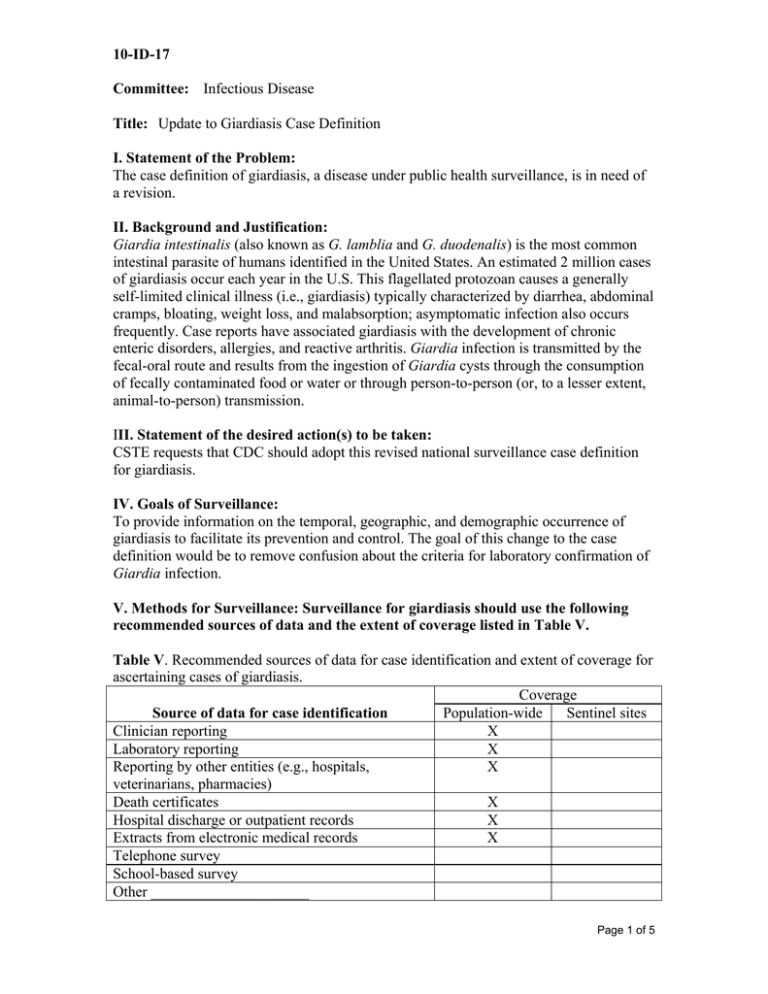
10-ID-17 Committee: Infectious Disease Title: Update to Giardiasis Case Definition I. Statement of the Problem: The case definition of giardiasis, a disease under public health surveillance, is in need of a revision. II. Background and Justification: Giardia intestinalis (also known as G. lamblia and G. duodenalis) is the most common intestinal parasite of humans identified in the United States. An estimated 2 million cases of giardiasis occur each year in the U.S. This flagellated protozoan causes a generally self-limited clinical illness (i.e., giardiasis) typically characterized by diarrhea, abdominal cramps, bloating, weight loss, and malabsorption; asymptomatic infection also occurs frequently. Case reports have associated giardiasis with the development of chronic enteric disorders, allergies, and reactive arthritis. Giardia infection is transmitted by the fecal-oral route and results from the ingestion of Giardia cysts through the consumption of fecally contaminated food or water or through person-to-person (or, to a lesser extent, animal-to-person) transmission. III. Statement of the desired action(s) to be taken: CSTE requests that CDC should adopt this revised national surveillance case definition for giardiasis. IV. Goals of Surveillance: To provide information on the temporal, geographic, and demographic occurrence of giardiasis to facilitate its prevention and control. The goal of this change to the case definition would be to remove confusion about the criteria for laboratory confirmation of Giardia infection. V. Methods for Surveillance: Surveillance for giardiasis should use the following recommended sources of data and the extent of coverage listed in Table V. Table V. Recommended sources of data for case identification and extent of coverage for ascertaining cases of giardiasis. Coverage Population-wide Sentinel sites Source of data for case identification Clinician reporting X Laboratory reporting X Reporting by other entities (e.g., hospitals, X veterinarians, pharmacies) Death certificates X Hospital discharge or outpatient records X Extracts from electronic medical records X Telephone survey School-based survey Other _____________________ Page 1 of 5 VI. Criteria for Case Identification A. Narrative: A description of suggested criteria for case ascertainment: Report any illness to public health authorities that meets any of the following criteria: 1. Any person who has a positive laboratory test for any Giardia species. These tests may include any of the following: a.) detection of Giardia organisms in stool, intestinal fluid, tissue samples or biopsy specimens b.) detection of Giardia antigen by immunodiagnostic methods c.) detection of Giardia-specific nucleic acid in stool, intestinal fluid, tissue samples or biopsy specimens 2. Any person with at least one gastrointestinal symptom of illness such as diarrhea, abdominal cramping, fever, nausea, vomiting or anorexia and who is either a contact of a confirmed case of giardiasis or a member of a risk group as defined by the public health authorities during an outbreak. 3. A person whose healthcare record contains a diagnosis of giardiasis. Other recommended reporting procedures: - All cases of giardiasis should be reported. - Reporting should be ongoing and routine. - Frequency of reporting should follow the state health department’s routine schedule. B. Table of criteria to determine whether a case should be reported to public health authorities: Table VI-B. Table of criteria to determine whether a case should be reported to public health authorities. Requirements for reporting are established under State and Territorial laws and/or regulations and may differ from jurisdiction to jurisdiction. These criteria are suggested as a standard approach to identifying cases of this condition for purposes of reporting, but reporting should follow State and Territorial law/regulation if any conflicts occur between these criteria and those laws/regulations. Giardiasis Criterion Clinical Evidence Diarrhea O Abdominal cramps O Vomiting O Fever O Nausea O Anorexia O Healthcare record contains a diagnosis of giardiasis S Laboratory evidence Giardia organisms in stool, intestinal fluid, tissue samples or S biopsy specimens Giardia antigens in stool or intestinal fluid S Page 2 of 5 Giardia specific nucleic acid in stool, intestinal fluid, S tissue samples or biopsy specimens Epidemiologic evidence Contact of a confirmed case of giardiasis O Member of a risk group as defined by the public health O authorities during an outbreak Notes: S = This criterion alone is Sufficient to identify a case for reporting. O = At least one of these “O” (Optional) criteria in each category (e.g., clinical evidence and laboratory evidence) in the same column—is required to identify a case for reporting. C. Disease-specific data elements: Clinical Information HIV infection Cancer chemotherapy On treatment with immunosuppressive drugs Epidemiological Risk Factors Daycare center attendee Child care worker International travel Drinking untreated water Contact with recreational water Contact with a confirmed case of giardiasis VII. Case Definition for Case Classification A. Narrative: Clinical description: An illness caused by the protozoan Giardia lamblia (aka G. intestinalis or G. duodenalis) and characterized by gastrointestinal symptoms such as diarrhea, abdominal cramps, bloating, weight loss, or malabsorption. Laboratory criteria for diagnosis: Laboratory-confirmed giardiasis shall be defined as the detection of Giardia organisms, antigen, or DNA in stool, intestinal fluid, tissue samples, biopsy specimens or other biological sample. Case classification Confirmed: a case that meets the clinical description and the criteria for laboratoryconfirmation as described above. When available, molecular characterization (e.g., assemblage designation) should be reported. Probable: a case that meets the clinical description and that is epidemiologically linked to a confirmed case. Page 3 of 5 B. Classification Tables: As appropriate, list criteria for: Confirmed Cases: cases with the highest level of certainty Probable/Presumptive Cases: cases where alternative etiologies were investigated and excluded, and/or where substantial supportive information for the diagnosis was found Suspected/Possible Cases: cases where clinical features were compatible with the diagnosis, but either further investigation is required or investigation of the case did not provide supporting evidence for the diagnosis. Table VII. Criteria for case classification for a case of giardiasis Confirmed Probable Criterion Clinical Evidence Diarrhea O Abdominal cramps O Vomiting O Fever O Nausea O Anorexia O Healthcare record contains a S diagnosis of giardiasis Laboratory evidence Giardia organisms in stool, S intestinal fluid, tissue samples or biopsy specimens Giardia antigens in stool or S intestinal fluid Giardia-specific nucleic acid in S stool, intestinal fluid, tissue samples or biopsy specimens Epidemiologic evidence Contact of a confirmed case of O giardiasis Member of a risk group as defined O by the public health authorities during an outbreak Notes: S = This criterion alone is Sufficient to classify a case. O = At least one of these “O” (Optional) criteria in each category (e.g., clinical evidence and laboratory evidence) in the same column—in conjunction with all “N” criteria in the same column—is required to classify a case. VIII. Period of Surveillance: Ongoing. This revision of the surveillance case definition will be effective January 1, 2011. Page 4 of 5 IX. Data sharing/release and Print criteria: Notification to CDC of confirmed and probable cases is recommended. Data are reported to NNDSS and summarized weekly in the MMWR. Case counts of giardiasis are also published annually in the MMWR Summary of Notifiable Diseases and biennially in the MMWR Surveillance Summaries for cryptosporidiosis and giardiasis. State-specific data are published weekly in the MMWR and annually in the MMWR Summary of Notifiable Diseases. Data on giardiasis are also published biennially in the MMWR Surveillance Summaries for cryptosporidiosis and giardiasis. Summary data on cases of giardiasis are published biennially in the MMWR Surveillance Summaries and may be included in MMWR or journal articles. X. References: Position Statement 2001-ID-08 Adding Giardiasis as a Nationally Notifiable Disease XI. Coordination: Agencies for Response: (1) Thomas R Frieden, MD, MPH Director Centers for Disease Control and Prevention 1600 Clifton Road, NE Atlanta GA 30333 (404) 639-7000 txf2@cdc.gov XII. Submitting Author: (1) Kristy Bradley, DVM, MPH State Epidemiologist & State Public Health Veterinarian Oklahoma State Department of Health 1000 NE 10th St Oklahoma City, OK 73117-1299 (405) 271-4060 kristyb@health.ok.gov (2) Michael Beach Centers for Disease Control and Prevention 4770 Buford Highway, NE Atlanta, GA 30341 770-488-7763 mbeach@cdc.gov Page 5 of 5
